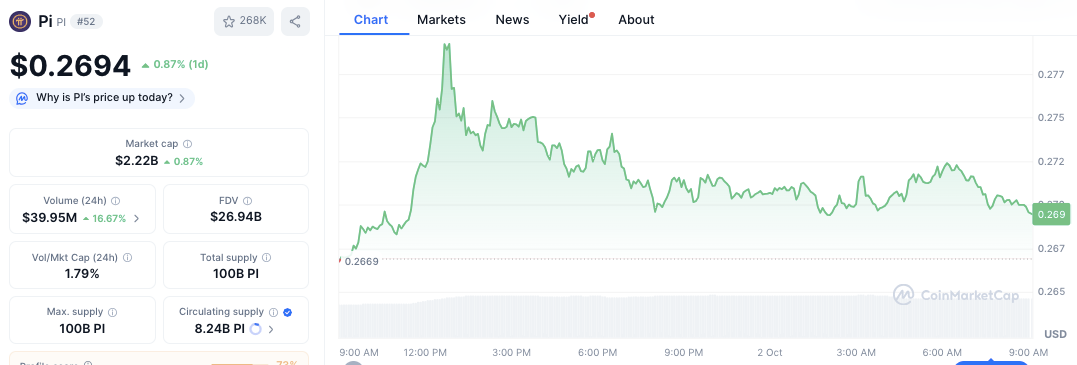Over the previous few months, a brand new class of publicly traded corporations have been vying to build up billions of {dollars} in cryptocurrencies. The following largest technique after Michael Saylor's Bitcoin-focused technique is Bitmine Immersion (BMNR), chaired by Wall Road strategist Tom Lee, which presently holds about 3.75% of the ETH provide, in keeping with knowledge from Blockworks Analysis.
That begs the query. Will Digital Asset Treasury (DAT) flip its steadiness sheet into protocol leverage?
Thinkcracy Capital's Ryan Watkins means that in precept DAT might acquire substantial affect, however skeptics counter that Ethereum's governance processes, consumer variety, and cussed “social layer” of validators make full management not possible.
Though the problem shortly enters the realm of hypothesis, Watkins says it's clear that Bitmine is in a privileged place amongst DATs on account of its excessive buying and selling quantity.
“BitMine trades on common over 10 instances extra quantity (in comparison with SBET) every day,” Watkins advised Blockworks. “This permits us to lift funds shortly to buy ETH, and can proceed to scale.”
 At this scale, few different ETH DATs register. sauce: Block Works Analysis
At this scale, few different ETH DATs register. sauce: Block Works Analysis
When is DAT vital?
Nonetheless in its early levels, DAT remains to be primarily centered on methods to extend the nationwide treasury. Watkins outlined the potential arc for well-funded DATs if the flywheel of straightforward capital slows.
“Sooner or later, I believe the alchemy of mNAV will cease working as effectively. You then'll see BitMine begin to get extra inventive and proactive, like deploying ETH on-chain and beginning to turn out to be a much bigger participant within the Ethereum economic system,” he mentioned.
The affect will most probably be cumulative not directly, impacting software governance first. If DAT maintains nine-digit balances on Aave or any main liquid staking protocol, that view will carry weight.
“In the event you're an Aave and Tom Lee has 10 to twenty p.c of your deposits, you may want his opinion earlier than making any huge adjustments,” Watkins mentioned.
In that case, possession of the infrastructure could come up. If DAT begins manipulating validators, RPCs, and indexers at scale, the person referred to as could change as parameters or consumer growth priorities change.
Expertise acquisition can also be a threat. Whereas merely hiring or beginning a core growth group received't transfer Ethereum's governance course of, a dense cluster of researchers and consumer contributors underneath a single monetary management might present a type of mushy energy.
Loading tweets..
Dr. Paul Dylan Ennis, a lecturer at College Faculty Dublin (referred to as Polar in X) and avid Ethereum governance watcher, is pushing in a distinct course. Ethereum isn’t an organization, and the Ethereum Basis isn’t a administration group.
“It's a bizarre polycentric system with individuals who particularly selected that ethos, and it's slightly bit ideological,” Dylan-Ennis advised Blockworks.
He understands the premise that “cash speaks,” and with sufficient scale, somebody like Lee might leverage his ETH holdings to form the course of Ethereum.
“However that could be a basic misunderstanding of how Ethereum works culturally and structurally,” Dylan Ennis mentioned.
Ethereum's governance construction, consisting of AllCoreDevs (ACD) Cole, EIP editors, Cat Herders, and others, is aimed toward coordinating processes, not earnings. To “take over” Ethereum, DAT might want to construct consensus with consumer groups and persuade a globally distributed base of node operators and validators to run its most well-liked code.
At the moment, public trackers are exhibiting greater than 10,000 to fifteen,000 Ethereum nodes worldwide. That is spread-based, requiring you to opt-in to any adjustments. In Dylan Ennis' view, that is way more cumbersome than hiring just a few senior engineers.
“Ethereum might be not an ideal instance,” Watkins mentioned, noting that the governance course of is “messier” than “democracy or plutocratic governance techniques the place it’s clear who has energy (and the way a lot energy).”
“With Solana, it's easier,” Watkins mentioned. “You maintain a number of tokens and also you vote with these tokens. That's the affect.”
Nevertheless, he mentioned DAT is “in a speculative incubation interval and we’re in search of the quickest technique to increase these treasuries.” Proper now, when you're efficiently scaling a DAT like BitMine, there's no stress to be inventive together with your governance. Not less than not but.
Smaller Treasury departments are already conducting cutting-edge experiments. “They should discover a technique to stand out,” Watkins mentioned. So that you see, for instance, ETHZilla is placing a whole lot of hundreds of thousands of {dollars} into the liquid staking ecosystem.
BitMine hasn't executed that but, but it surely's doable.
 Tom Lee's BitMine Immersion Applied sciences Inc (BMNR) leads by a large margin in ETH holding race amongst DATs | Supply: Block Works Analysis
Tom Lee's BitMine Immersion Applied sciences Inc (BMNR) leads by a large margin in ETH holding race amongst DATs | Supply: Block Works Analysis
Ethereum's immune system
Dylan Ennis' counterargument is that Ethereum's governance has repeatedly been extra about prudence than expediency. The “immune system” for this venture is a mix of processes and cultures. A tough consensus on ACD, a conservative consumer group throughout each the consensus and enforcement layers, and a membership of node operators who put ideology first and revenue second.
There are not any shortcuts to constructing social consensus round EIP opinions, consumer implementations, and chain upgrades. A putative DAT push would nonetheless face these bottlenecks.
Coinbase (or any key stakeholder) can present enter identical to every other firm, however historical past has proven that in trusted, impartial techniques, extraordinary stress from corporations can backfire. The closest historic analogy lies exterior of Ethereum. In Bitcoin's 2017 block measurement conflict, a coalition of miners, exchanges, and VCs supported SegWit2x, but it surely misplaced to user-led opposition.
Dylan Ennis argues that the most probably end result of coercive stress isn’t seize, however a hard-forked ghost chain and a reputational backlash towards those that tried, very like Bitcoin Money (BCH) immediately.
Stablecoin issuers and exchanges can affect which forks “win” by deciding what they help. Precisely what occurred in the course of the 2022 merger when Circle (USDC) and Tether (USDT) dedicated to supporting solely proof-of-stake chains, ravenous PoW forks with oxygen. Even when governance breaks down sooner or later, comparable collaboration dynamics are more likely to emerge.
Watkins cited Joe Freeman’s essay “Tyranny with out Construction” as a possible critique of Ethereum’s governance. As formal authority weakens, a casual middle of gravity emerges. “It's not clear who has the facility,” he mentioned. That doesn't imply it lacks energy.
“A powerful candidate to turn out to be certainly one of these facilities is somebody who holds a ten% pile of ETH,” Watkins mentioned. In that world, affect means constructing alliances with bigger stakeholders, resembling exchanges and asset managers, and successful over the “hearts and minds” of operators within the ecosystem to get sure releases shipped.
The cures on this essay (with clear authority) are in keeping with continued efforts to refine and enhance EIP/ACD procedures and recommend that Ethereum's greatest protection towards doable seize is extra daylight, not much less.
But it surely must be genuine. Earlier analyzes of open supply software program communities have pointed to comparable dynamic Freeman flags. In different phrases, the rhetoric of openness can masks entrenched casual hierarchies. It is a helpful context for evaluating claims resembling “anybody can suggest an EIP.”
unanswered questions
For now, Watkins sees Tom Lee's affect as restricted, partly as a result of steadiness sheet enlargement stays the important thing occasion. “He’s not even operating a full node,” Watkins mentioned, including that staking by way of an administrator could also be conserving BitMine’s ether from impacting day by day consumer releases and parameter adjustments within the quick time period.
Nevertheless, the tempo of accumulation and the willingness of smaller DATs to enter infrastructure, DeFi, and validator operations makes this greater than only a thought experiment.
Blockworks reached out to BitMine representatives for touch upon future plans, however didn’t obtain a response on the time of publication.
“It stays to be seen what the ultimate state of those monetary corporations will likely be,” Watkins mentioned. As DAT evolves from a value guess to a coverage instrument, Ethereum’s norms will likely be put to the take a look at in public.


